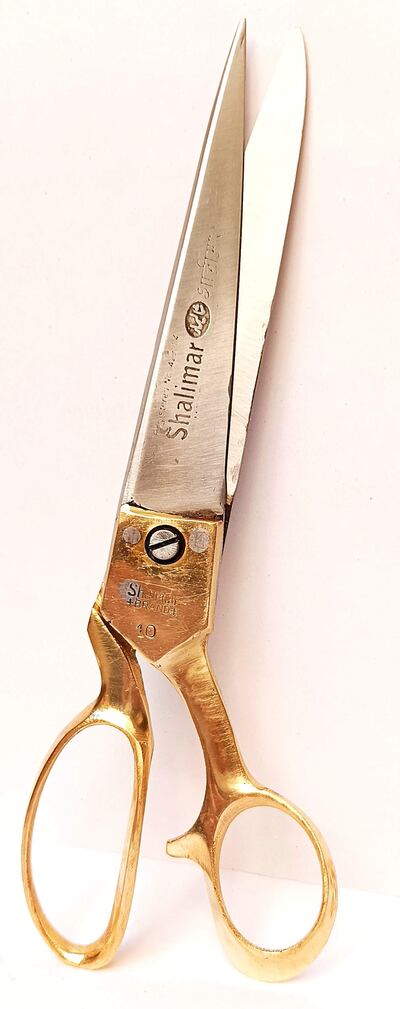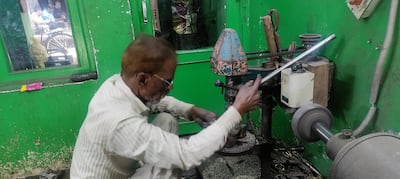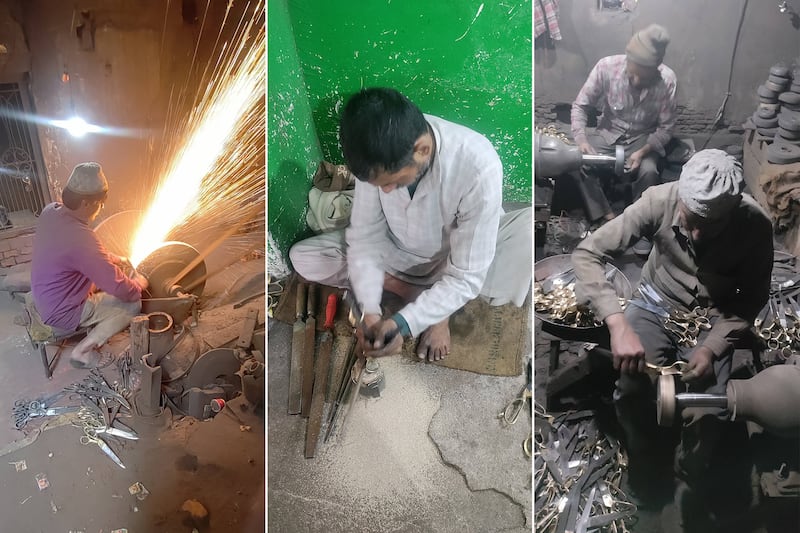Under the light of a dim bulb, with the smell of chemicals and metal dust pervading the air, a craftsman sits cross-legged, meticulously carving the blades of a pair of scissors.
Two others seated on a stool grind the blades, russet sparks flying around them. Another elderly artisan clicks an almost-ready pair of scissors, listening for the sounds that will inform his well-trained ears whether or not a pair is working well.
Sharp quality

Tanseer Saifi of Shalimar Scissors is showing The National around his unit. He is the fifth-generation member of his family’s scissor-crafting business, which was started by his grandfather almost a century ago.
Saifi grew up seeing his father work and learn the craft in the bustling industrial town of Meerut in India. Located 100 kilometres from Lucknow, the capital of Uttar Pradesh, Meerut has been home to the ancient cottage industry of hand-forged scissors for more than 300 years.
Apocryphal it might be, but the story — at least in the alleyways of Meerut — goes that that in 1654, a local blacksmith put two swords together when he wanted to cut leather, thus making the first pair of scissors known to mankind. The craft grew in the Mughal period with the skill being passed on from generation to generation.
It is also said Meerut scissors have their origins in the city’s penchant for consuming paan or betel leaf, because a betel nut-cutter needed razor-sharp blades.
To date, the city’s Kainchi Bazaar resonates with the sounds of hammering and grinding. The scissor market has more than 250 small units employing more than 70,000 people who make up to 16 varieties of scissors. These are then shipped across the country and abroad.
The scissors of Meerut are known for their cutting precision, and have been used for centuries by tailors, barbers, industrial garment and leather units, offices and private homes. A popular saying in Meerut points to the long life and quality of the scissors produced here: “Dada le potaa barpe”, which means something bought by the grandfather that can still be used by the grandson.
Each pair passes through a series of processes from sharpening and welding to polishing. Unlike other “use-and-throw-away” scissors, those coming out of Meerut can be resharpened and reused any number of times, and can slice through many folds of fabric.
A painstaking process

The pieces are ergonomically designed with brass handles fused on to the blades. Making these scissors is an art that involves an array of craftspeople with different skills.
“The handles are so well designed they never leave marks on your hands, and the grip exerts power and precision in cutting,” explains Hamid Bhai, a tailor in Chennai, who has been using these scissors for decades.
“What sets these scissors apart is that they are made of recycled metal scrap. All the parts that go into making a pair of Meerut scissors are upcycled in some way. The blades are made from upcycled carbon steel that is scrap metal salvaged from the railways, buses, trucks and the automobile industry, and they are plated with nickel or chromium so they do not rust,” says Aadil Qureshi of Diamond Scissors, another unit in the market that was launched in the 1980s.
“The handles are usually made of metal alloys that are prepared by upcycling old utensils. The two blades are held together by adjustable metal screws, and the blades are arched in such a way they achieve a friction and tension between the two edges.”.
“Our scissors can be used for years on end with just some resharpening. There are as many as 22 hands that a pair of scissors passes through in its manufacturing cycle and, except for a few machines like grinders, they are handmade. We make scissors in sizes to suit all needs, from household to tailors and barbers,” says Saifi.
Most of the artisans have learnt from their mentors or employers through the prevalent “ustaad-apprentice” system. In 2013, Meerut scissors were awarded a Geographical Indication tag, which is a sign that attests a product has a specific geographical origin and possesses special qualities, so no duplicates can be passed off as the original product.
The city’s artisans make scissors for different uses, from paper and cloth to wire-cutting. Each type has a specific length, weight and blade size, and the price ranges from 100 Indian rupees to 1,000 Indian rupees ($1 to $13).
While men do all the work involved in making the scissors, women are employed in packing and quality-checking. Most workers are paid a wage of 200 Indian rupees to 400 Indian rupees a day for this back-breaking work.
Cutting through challenges
The manufacturing of Meerut scissors has been beset by problems in recent times, despite the pandemic offering a slim ray of hope.
The small factories and workshops have frequent power shutdowns and poor ventilation. Workers often suffer from respiratory diseases as they inhale metal dust particles on a daily basis; others suffer cuts and injuries performing hazardous operations, such as sharpening and welding.
In the past few years, flimsy but cheaper machine-made scissors from China and other markets have taken over. “The Chinese scissors have a better finish and look stylish, but last just for a year compared to ours, which can last as long as 10 years,” says Saifi. “Their price is attractive, at only around 200 rupees, and they are taking away our market.
"However, during the Covid19 lockdown, when Chinese scissors could not be procured, our demand went up manifold, as people had to cut their hair at home instead of at salons that were closed.”
Even so, the younger generation do not want to get into this business owing to its low margins. Only a handful of youngsters are currently getting trained to carry on this legacy.
The price of raw materials such as brass, too, has gone up in the past few months, coupled with an increase in the rate of India’s Goods and Services Tax. At present, more than 50 per cent of the units in Kainchi Bazaar remain closed.
“We have made many [requests] to the government to help us by increasing the import tax on Chinese scissors, and letting this ancient craft survive,” says Saifi, who is also trying to modernise and market Shalimar Scissors through Instagram. “Until then, we can only continue to do what we have done for generations and live in hope.”





